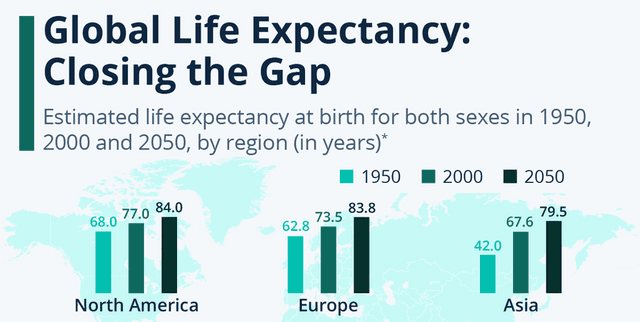Historical Gender-Specific Life Expectancy Data
Patient Health Records & Digital Health
Tags and Keywords
Trusted By




"No reviews yet"
Free
About
Offers a detailed historical record of global life expectancy, with data spanning from 1960 to the present. The data is curated to allow for in-depth analysis of trends over time and gender-based disparities in life expectancy around the world. It serves as a rich resource for understanding long-term developments in global health and demography.
Columns
- country_code: A unique identifier for each country (Alpha 3 Code).
- country_name: The official name of the country.
- region: The broad geographical area where the country is located (e.g., Asia, Europe).
- sub-region: A more specific regional classification within the broader region.
- intermediate-region: An additional, more granular geographical grouping, where applicable.
- year: The specific year the data pertains to.
- life_expectancy_women: The average number of years a woman is expected to live in that country for the given year.
- life_expectancy_men: The average number of years a man is expected to live in that country for the given year.
Distribution
The dataset is provided in CSV format with a size of 881.41 kB. It contains 13,500 records across 8 columns.
Usage
Ideal applications for this dataset include analysing time series trends to forecast future changes and evaluating the impact of health policies. It is also well-suited for studying gender disparities, conducting regional and sub-regional analyses to understand geographical differences, and supporting public policy research by linking life expectancy to socioeconomic developments. Furthermore, it can be used as a teaching tool for courses in public health and data analysis.
Coverage
The dataset provides global coverage, including data for 215 unique countries across various regions and sub-regions. The time range spans from 1960 to 2022. The data is broken down by gender, covering both men and women. The
intermediate-region column has missing values for 58% of the records.License
CC BY-NC-SA 4.0
Who Can Use It
- Researchers and Academics: For analysing long-term trends in global health, demography, and gender studies.
- Public Policy Analysts: To inform health policies by linking life expectancy data with socioeconomic indicators.
- Data Scientists and Students: As a practical dataset for projects involving time series analysis, data visualisation, and exploring global demographic trends.
- Educators: As a teaching resource for courses on public health, global development, and data analysis.
Dataset Name Suggestions
- Global Life Expectancy by Gender (1960-Present)
- Historical Gender-Specific Life Expectancy Data
- Worldwide Life Expectancy Trends Since 1960
- Gender Disparities in Life Expectancy Dataset
Attributes
Original Data Source: Historical Gender-Specific Life Expectancy Data
Loading...
